Why can’t I get a proper cup of coffee in France? This is a question I am often asked by disappointed Australians and Americans who are used to a very wide variety of coffee beverages and are surprised to see that France, with its café culture, does not seem to have the coffee they are looking for.
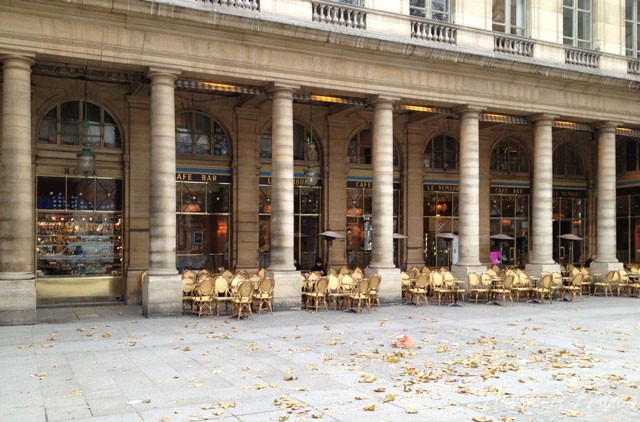 Autumn leaves in front of Café Nemours on Place Colette, one of the most iconic cafés in Paris
Autumn leaves in front of Café Nemours on Place Colette, one of the most iconic cafés in ParisWell, the reason is that it’s a café culture, but not a coffee culture. The French don’t walk down the street sipping from a cup. They either drink their coffee standing at the bar or sit down at a table.
Perhaps a little history of Australian coffee might help. To quote Aussie expat Luke Barclay, from Café de la Baie near the Mont Saint Michel : “France doesn’t have a highly developed coffee culture like Australia does. Historically coffee is relatively recent in Australia – we are essentially English in culture up until a point and thus tea was the thing. But with post war immigration came coffee styles from around the world and these blends led to the highly specific style that is found in Australia and New Zealand – quite different to that found in North America and yet composed of pieces from European (and Eurasian) coffee. That said there is a complacency with many businesses and their coffee. I know from my Café de la Baie that the majority of French ask simply for a “café” as if there is only one style available and this is despite café au lait existing here as much as espresso. Thus few varieties are proposed by cafés. Further, the advent of automatic machines in France has reduced the quality. Those that make coffee know less and less about the techniques, quality is lost, machines aren’t cared for (or kept clean!). Temperatures, timing, ratio, grind qualities: all sorts of variables and most cafés just push a button and assume its a good brew.”
In France, in a normal café, you can have expresse (or expresso – note the “x”), café long, café au lait, café crème, café noisette and cappuccino (but not always – I remember a café in a small town in Brittany where we stayed several days where only one person could make it and she wasn’t always there). In more sophisticated cafés, especially in Paris, you might be able to get other types, but they are usually brasseries or cafés catering to tourists.
Baristas, as such, do not exist in France, as they are not considered necessary.
In Paris, a typical expresse is very “serré” which means that it has been tamped to death and is usually very bitter. Outside Paris, it is usually not as strong and therefore not as bitter. It is generally served in a small cup or tasse but not a ½ tasse as it is in Italy. It is considered a must after a meal but is also popular at other times during the day as a pick-me-up.
When I first came to France in 1975, all homes had a drip coffee machine and a coffee grinder but nowadays most people have an espresso machine of some sort and buy pods.
A café long is sometimes called an américain or Americano and served in a bigger cup. It is a weaker version of the expresse and made with a double dose of water.
A café noisette is an expresse to which a teaspoon of foamed milk is added. However, in some bars, they just add a drop of cold milk.
A café crème is an Americano to which a spoon of whipped cream has been added. It is often referred to as a grand crème.
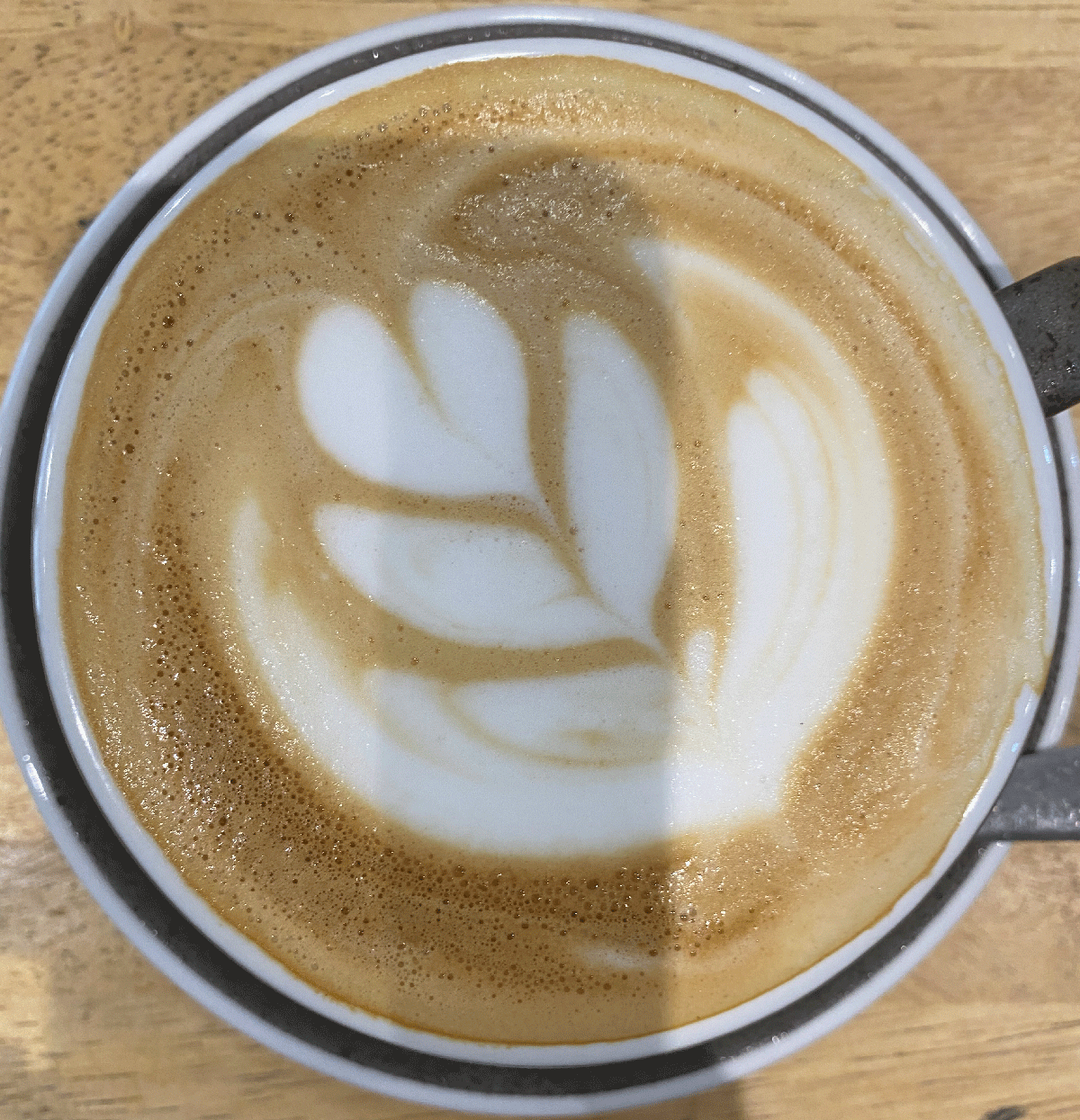 A real cappuccino at Kat’s Coffee in Tours
A real cappuccino at Kat’s Coffee in ToursWe all know what a cappuccino is – until we get to France! Here it is considered to be an expresso topped with milk froth and sprinkled with cocoa. Now that automatic espresso machines are widespread, that version has definitely become the norm. If you want a creamy foamed milk cappuccino à l’italienne, you first have to check they have a machine with a wand and even then, as you can see in the photo below, there can be surprises. I rarely order cappuccino because I am invariably disappointed, except for a café in the city of Tours called “Kat’s Coffee” which has the real thing. I haven’t found a real cappuccino in Blois yet. If you don’t want it automatically sprinkled with cocoa you have to say so.
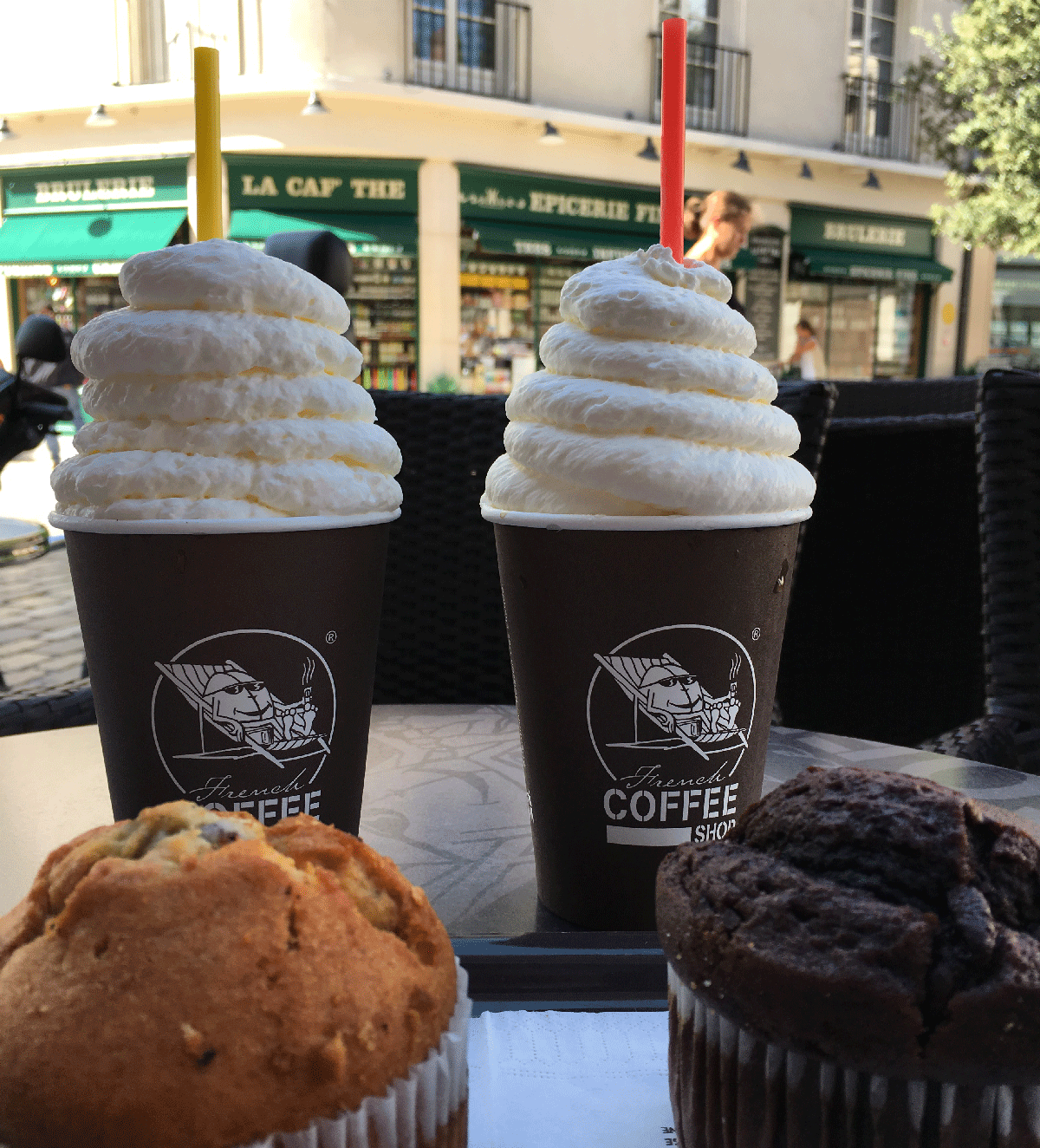 A cappuccino at The French Café in Blois
A cappuccino at The French Café in BloisIn Normandy in particular where they put cream in everything they can, a cappuccino is made with whipped cream and not foamed milk.
A café au lait is coffee to which warm milk has been added. It is the traditional French breakfast drink. After childhood, French people rarely drink milk without something in it, such as chocolate or coffee. A café au lait is also a way of introducing children to black coffee. As time goes on, you add less milk.
You can usually have most of these in a decaffeinated version, called déca. If you just ask for a déca it will be the expresse version. Otherwise ask for café au lait déca, grand crème déca, etc.
The word “café” by itself in French always means black coffee. You have to qualify it if you want something else. You always add your own sugar which is often in lump form (even in people’s homes) or in a sachet. You rarely see coffee crystals but you sometimes find brown sugar. Sugar substitutes are becoming more readily available.
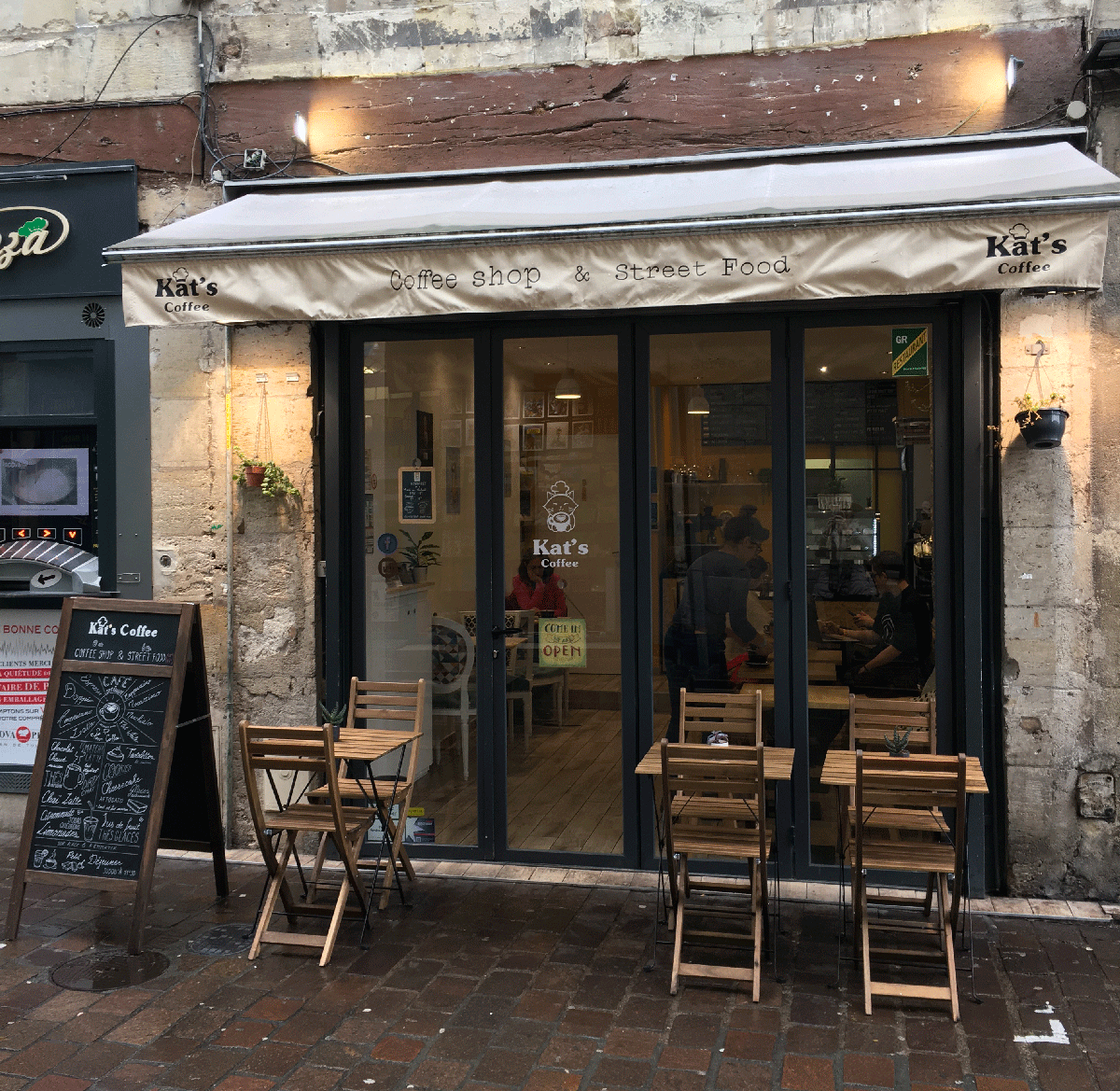 Kat’s Coffee in Tours
Kat’s Coffee in ToursAll these drinks can be ordered simply by saying their names and adding “s’il vous plait” e.g. un expresso s’il vous plait”, “un grand crème s’il vous plait”, etc. If you want to check you are getting (almost) real cappuccino, you can ask “est-ce que vous faites vous-même la mousse de lait?” And if you don’t want cocoa on top “je ne veux pas de cacao dessus ».
The French do, however, appreciate different types of coffee beans, and specialists such as Verlet near the Palais Royal, serve a huge variety of beans. The owners travel the world to select suppliers and roast their own coffee. Closer to home, Jean-François, on Blois market, has a large selection of home-roasted coffee beans where we always buy our coffee. Each week, he has a blend-of-the-day to try on the spot. There is often a coffee menu in gastronomical restaurants. These select coffees are usually served black with no sugar so you get the real taste.
Another notable difference between French and Australian coffee is that robusta coffee (produced for the former French colonies) is mainly used in France rather than the less bitter, more flavoursome arabica variety.
Milk can also make a difference. In France, milk is usually long-life (UHT) and I’ve never seen any other kind in a French café. I don’t know whether this is the case in Italy, home of the cappuccino, but I suspect it is.
A word of advice about iced coffee. This is not something that people drink in France.
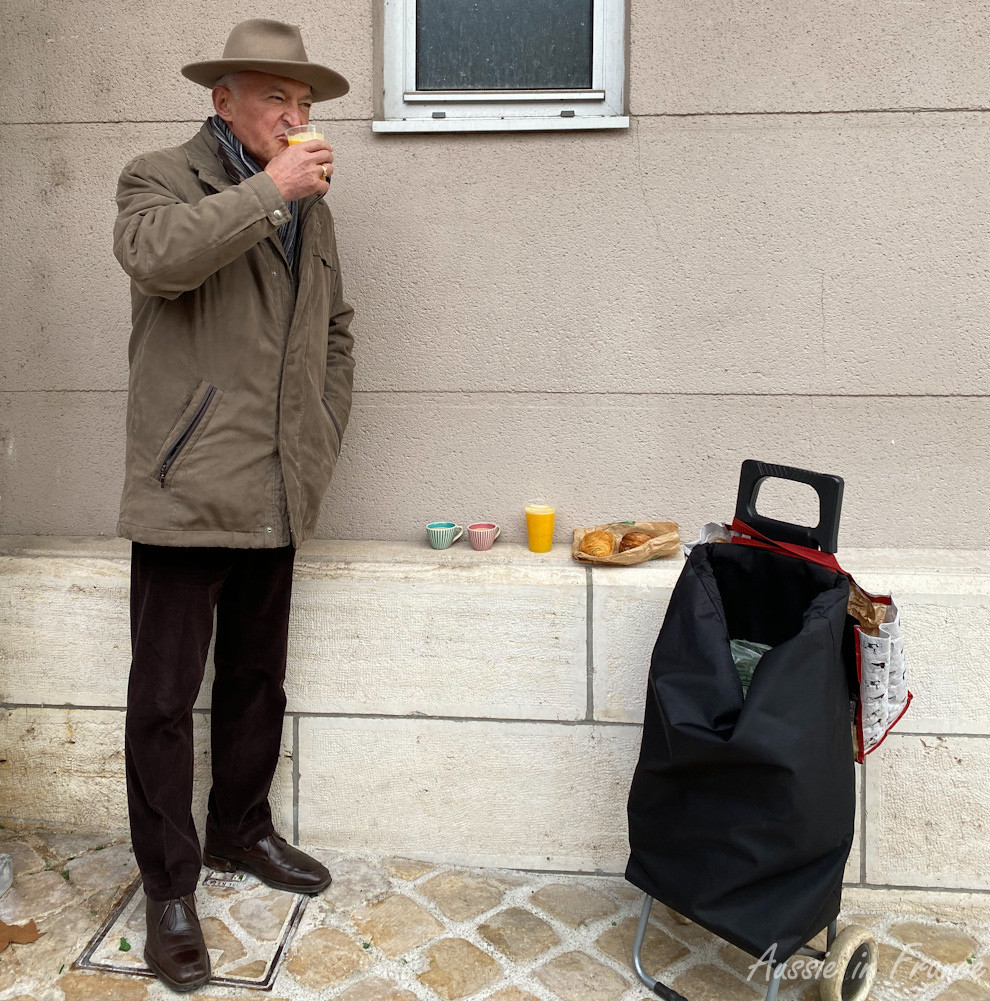 Coffee at the market in Blois (during Covid, so distancing)
Coffee at the market in Blois (during Covid, so distancing)And I can’t end this post without mentioning the wonderful Café (or Thé) Gourmand available in most French brasseries and restaurants. This is a coffee served at the end of a meal with a variety of four or five mini-desserts that change according to the ingredients the chef has at hand. They are a wonderful end to a meal if you can’t decide which dessert to choose! I have written a separate post about them here.
If you have found any good coffee shops or cafés in France that you’d like to recommend, please tell me and I’ll add them to my list. Many of those mentioned do their own roasting and sell beans.
Amboise: Eight O’Clock, 38 Place Michel Debré
Arles: Café Bazar, 8 place Antonelle
Bordeaux:
Sip Coffee (Aussie-type), 69 bis rue des Trois-Conils
Café Piha (Kiwi-type), 69 rue des Ayres
Alchimiste: 12, rue de la Vieille Tour + 87 Quai Queyries (Darwin)
Contrast: 16 cours du Chapeau-Rouge
Caen: Keys & Co (Kiwi-owned), 45 avenue 6 juin in Caen
Grenoble:
Brûlerie des Alpes, 56 cours Jean Jaurès
Tower Coffee, 6 place du Docteur Léon Martin
Café Myrö, 12 rue Jean Jacques Rousseau
Kai Iwi (Kiwi-owner), 5 rue des Clercs
Marseille:
7VB Café, 9 rue Caissière (2nd)
Café Piata, 14 rue Breteuil (1st)
Café Coogee (Aussie-owned), 100 Boulevard Baille (5th)
Mont Saint Michel: Café de la Baie, Saint Léonard, Vains
Paris:
Hexagone (Melbourne-style), 121 rue Château (14th)
Coutume, 47 rue Babylone (7th)
Café Obrkof, 41 bd Voltaire (11th)
Café Méricourt, 22 rue Folie Méricourt (11th)
Hollybelly Café (Melbourne-inspired), 5 rue Lucien Sampaix (10th)
KB Cafeshop, 53 avenue Trudaine (9th)
Café Yves Saint-Laurent, Rive Droite, rue du 29 juillet (1st)
Hardware Society Café (Melbourne owners): 10 rue Lamarck (Montmartre just next to Sacré Coeur)
The Good New Coffee Shop (Aussie-owned): 27 bis Rue Mademoiselle (15th)
O’Coffee (Aussie-owned): 23 Rue de Lourmel (15th)
Patrick’s Le Ballon Vert (pub with good coffee): 33 rue de Montreuil (11th)
Café Kitsune, 51 Galerie de Montpensier, Palais Royal (1st)
Toulouse: Café Cerise, 4 quai de la Daurade
Tours: Kat’s Coffee, 63 rue du Commerce
Versailles: The Stray Bean, 6 rue Royale



